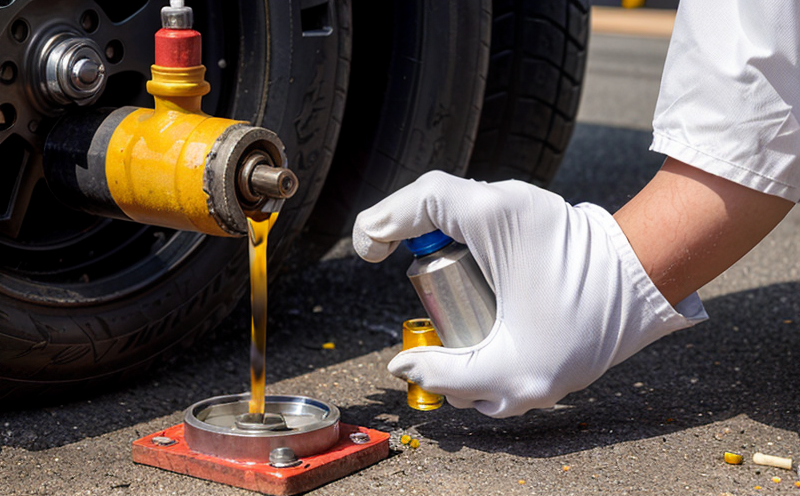ASTM D86 Distillation Range Testing of Petroleum Products
The ASTM D86 method is a standard practice for determining the distillation range and fractional distillation data of petroleum products. This testing procedure is crucial in ensuring that fuels, oils, and lubricants meet specified performance criteria, which are essential for engine efficiency, safety, and environmental compliance.
During this process, a sample of petroleum product is heated under controlled conditions until it begins to vaporize. The temperature at which the first drop of condensate appears in the receiver is called the initial boiling point (IBP). The test continues until all volatile components have been distilled off, and the final boiling point (FBP) is recorded.
The distillation range provides critical information about a petroleum product's volatility. This characteristic directly impacts engine performance, fuel efficiency, and emissions control. For instance, in marine applications, engines operate under varying conditions that require specific fuel characteristics to ensure optimal performance. ASTM D86 helps manufacturers and quality assurance teams verify the fuel specifications meet industry standards.
The testing procedure is conducted using a distillation apparatus equipped with a thermometer, condenser, and receiver. The sample is heated slowly according to precise temperature increments defined by the standard. During this process, the operator must carefully monitor the temperature at which various fractions of the petroleum product begin to vaporize.
The ASTM D86 method also provides fractional distillation data, which breaks down the distillation into specific ranges and volumes. These data points are essential for refining processes, where different components of a petroleum product can be separated based on their boiling points. This separation is critical in producing fuels with varying specifications, such as low-sulfur diesel or high-quality lubricants.
The precision and accuracy of ASTM D86 testing ensure that the resulting products meet regulatory requirements set by international standards like ISO 12580 for fuels or API SP for engine oils. Compliance is essential in ensuring safety at sea, where failures in fuel quality can lead to serious accidents.
| Industry | Application |
|---|---|
| Fuel Production | Determine the distillation range to refine fuel specifications. |
| Marine Engineering | Ensure compliance with engine performance standards for marine vessels. |
| Lubricant Manufacturing | Validate lubricants meet quality and performance criteria as per API SP specifications. |
| Environmental Compliance | Monitor fuel emissions to ensure they comply with environmental regulations. |
Applied Standards
The ASTM D86 method is widely recognized and used internationally. It adheres to the ISO standard for fuel distillation, which ensures consistency in testing across different regions. The procedure is detailed in ASTM D86, a document that specifies the apparatus and conditions required for accurate distillation range determination.
For marine applications specifically, compliance with API SP standards is crucial. These specifications ensure that lubricants and fuels meet stringent performance criteria necessary for reliable engine operation in challenging maritime environments. The testing procedures outlined by ASTM D86 play a vital role in meeting these standards.
- The initial boiling point (IBP) indicates the temperature at which the first drop of condensate appears, providing an early indication of fuel volatility.
- The final boiling point (FBP) marks the end of the distillation process and is critical for determining the overall distillation range.
Industry Applications
In marine engineering, ASTM D86 testing is a cornerstone of quality assurance. It helps in ensuring that fuels used in engines meet the stringent performance criteria set by API SP and ISO standards. This ensures that vessels can operate reliably under varying conditions, from calm seas to rough waters.
Fuel production facilities use ASTM D86 tests to refine petroleum products into various grades of fuel oil. By accurately determining the distillation range, producers can tailor their processes to meet specific market demands and regulatory requirements.
- For lubricant manufacturing, ASTM D86 is used to validate that lubricants comply with API SP specifications, ensuring they provide optimal protection for marine engines.
- In the environmental compliance sector, distillation range testing ensures fuels emit acceptable levels of pollutants, contributing to cleaner oceans and safer maritime operations.
Quality and Reliability Assurance
ASTM D86 is a critical tool in the quality control process. By accurately determining the distillation range of petroleum products, labs can ensure that fuels and lubricants meet the highest standards for performance and safety.
- The initial boiling point (IBP) helps identify the lowest temperature at which fuel begins to vaporize, ensuring engines start easily under cold conditions.
- The final boiling point (FBP) indicates the highest temperature at which the last fraction of the petroleum product distills off, providing insight into the overall composition and quality of the fuel.
By adhering to ASTM D86 standards, manufacturers can ensure that their products meet regulatory requirements and industry best practices. This not only enhances reliability but also builds trust with customers who rely on these products for critical operations.





